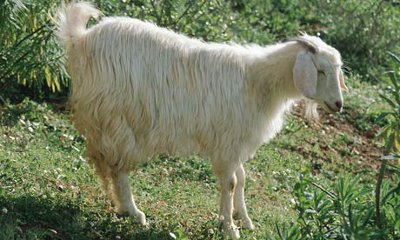Cashmere Goat
Category: Goat

Facts about Cashmere Goat, "Scientific name for Cashmere Goat is Capra aegagrus hircus". Cashmere Goat is a variety of goat that hails from Kashmir in India. This goat breed is a fiber goat together with the Nigora goat, Pygora goat, and the Angora goat. The Cashmere Goat is not a real goat breed, but a portrayal of a goat that has been vigilantly bred to create cashmere fiber. All Cashmere Goats of this variety produce two fiber coats such that the first coat guards their hair and the second coat is called a down coat that grows and sheds during the summer season. The Cashmere Goats are dual purpose animals as they are bred for low-fat meat and high-quality wool.
Features of Cashmere Goat
The Cashmere Goat breeds are healthy animals, trouble-free to develop and need minimal care. The Cashmere Goat are not hurdlers similar to several other goat varieties and normal woven rope sheep fencing will include them. Minimum shelter is required to accommodate the Cashmere Goat because of the insulating features of their double coat that sheds seasonally.
Cashmere Goats come in different colors, which make a group of Cashmere Goats appear similar to fairly an assortment. Goats with white-colored face are inclined to be dominant, but brown, black, red, grey, cream and badger faced goats are extremely common. The Cashmere Goat may also have either long or short protector hair.
The Cashmere Goats are inclined to be alert and suspicious, rather than passive and docile. These features are mainly because of their untamed origin, relatively only some generations back. The Cashmere Goat also inclined to be extremely good moms and easy kidders.
Reproduction of Cashmere Goat
Usually, the development period for female Cashmere Goats is 150 days, but it can differ some days each way. Usually, the kids are born, from late February to April or during the beginning of May. Mother Cashmere Goat will call their young so they stay close at all times, a baby goat is called a "kid". The Mother and kid goat recognize each others calls as soon as the mother gives birth. Baby Cashmere Goats are weaned off their moms after around 6 months. Its called "bleating" how goats communicate with each other. A "doe" or "nanny" is what a female Cashmere Goat is called. A "buck or "billy" is what they call a male Cashmere Goat. A male castrated goat is called a "wether". "Kidding" is the act of a goat giving birth.
Cashmere Goat breeds can be useful in several ways. The Cashmere Goats offer 3 to 4 ounces of fine, flexible fiber a year that can be made into wool for knitted clothes. The Cashmere Goat breeds are helpful for clearing fence lines and unwanted weeds. The pelts of the Cashmere Goats are used to make seat covers and rugs. The Cashmere Goat offer a healthy meat, which is low in cholesterol.
The average lifespan of the Cashmere Goat breed ranges from 10 years to 12 years. The goat is one of the 12 animals in the Chinese zodiac.
Goats can even climb trees because they have great balance and some goat species can jump over 5 feet high. A Cashmere Goats eyes are rectangular rather than round. At night they have excellent vision and can due just as much at night. A goat herder notice how much energy his goats had, after eating coffee bushes and that's how coffee was first discovered. There are over 210 breeds of goats in the world. Cashmere Goats have no teeth in their upper front jaw. Cashmere Goats have 24 molars and 8 incisors. Both sexes, female and male goats can have beards. Male Cashmere Goats reach puberty at the age between 4 to 8 months and the female Cashmere Goat is between 7 to 10 months. Male goats at the beginning of mating season go through a period called a "rut". The "rut" is the beginning of the courting for a doe, a very strong foul musky odor and fighting between bucks begins. Goats can be born without or with horns "polled". Cashmere Goats have a four chamber stomach, goats are "Ruminant" is any hoofed even-toed mammal, that digests its food in two stages. First by eating the raw materials and regurgitating a semi-digested form known as "cud" (ruminating: chewing the cud.) then eating the cud. "Wattles" is that little tufts of hair that dangles from the goats throat. Goats milk is higher in niacin, calcium and vitamin A than cows milk. A goat is a herbivores, that eats leaves, grass, hay and furns {plant eaters}
Tetanus is something to watch out for in Cashmere Goats and what are the proper shots to give them, (Tetanus-is an illness that is caused by Clostridium Tetany). Also do the research on de-worming your young Cashmere Goats (kids) and do the research on the proper doses. Also look up "Cocci" (If your fecal test shows an high rate of cocci (over 200 per gram) you need to take action quickly with your young (kid). These are important facts so do your research on this if you are raising Cashmere Goats, especially young Cashmere Goats (kids). Capra aegagrus hircus was derived from the Wild Goat (C. aegagrus). In latin "Capra" is the root of the word "capricious" which means whimsical, mischievous, quirky, bizarre and suitable to change fast.

 Back To Category Goat
Back To Category Goat